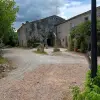Some twenty kilometres or so from Montpellier, not far from the Hérault gorges and Buèges, Saint-Martin-de-Londres is a place to discover and savour. Its authentic setting in the middle of the garrigue scrubland means it combines nature and culture.
This medieval village, typical of the region, takes visitors a few centuries back in time. Between its walls, you can stroll along the narrow streets, past houses with flower-filled balconies and beneath the picturesque stone arcades. The village's Romanesque church, founded in the 11th century by the monks of Gellone Abbey in Saint-Guilhem-le-Désert, is its greatest gem. Connected to the priory, the building with Byzantine influences is an architectural jewel combining understatement and harmony.
On Place de la Fontaine, a square adorned with fountains, you will see the Clock Tower. A remnant of the old surrounding wall built during the Hundred Years War, it was used as a prison during the Revolution. It's also worth stopping by the square next to it, to admire the beautiful façades that surround it. You can also enjoy the soothing shade of the century-old plane trees that stand proudly near the fountain...
The village of Saint-Martin-de-Londres has one of the best preserved Romanesque monuments in Languedoc through its church, hidden behind a medieval wall, halfway between Montpellier and the Cévennes.
In the 11th century, Romanesque art which spread in Languedoc was characterized by a strong Lombard influence.
In the Hérault, at Saint-Martin-de-Londres, it manifests itself in the church built at the beginning of the century by the monks of the abbey of Saint-Guilhem-du-Désert on one of the paths of Saint- Jacques de Compostelle (Arles route). Historical monument, it never ceases to intrigue: why such a masterpiece of architecture, such ornamental wealth, in this small village? The story, long and fascinating, deserves a stop. The building is set in a fortified enclosure to which lean the houses of character.
The "first Romanesque art" bursts forth in its simplicity and harmony on the walls of the church. Inside, the architecture is consistent with the time, but shows imagination (trefoil plan, dome, sculpted decoration). A second later wall is based on the first, delimiting, to the south, the medieval village with its characteristic houses.
Stroll through the alleys and descend to the square shaded by hundred-year-old plane trees then linger by the fountain.
What origin for "London"? In Celtic times, Llyn dinas, which became the city of London, referred to "the hill of the pond" among our English neighbors. In Languedoc, Loundro would have meant "mud, stagnant waters" and the terms Lundras, Lundrias, Doundras, which after mutation gave London, were used in medieval writings to characterize the valley which is now dry. However, it often remains drowned in the mist escaping from soils once invaded by swamps.
- Weekly market on Sunday morning.
- Donkey and Horse Fair in mid-May at Saint-Martin-de-Londres, north of Montpellier. Farm and playground for children, dozens of exhibitors (saddlers, craftsmen, equestrian centers...). Demonstrations of plowing, forging, training, handling, grazing, sheep shearing, team and workshop. Debates on the equine world. Individuals and professionals can participate in the Empty your Stables or Bring donkeys or horses for sale. Information at the Town Hall of Saint-Martin.
- Festi'Val in London in July.
Fete Votive
- From 26 april to 1 may 2024
- On April 26,27,28,30 and May 1, the Fête votive de Saint-Martin-de-Londres takes place for 5 days ! - DJs, orchestras, bullfighting, olympiads… and lots of surprises in store… - Full program on the Facebook page of the Comité des Fêtes de Saint-Martin-de-Londres.
Festival la Dinette - Spectacle Rhapsodies Nomades « get up ! Badaboum »
- On 24 may 2024
- Route des Cévennes
- Every year, Bouillon Cube's festival for young audiences, La Dinette, travels the region to meet youngsters and families, from May 3 to June 21,2024. - On the program : workshops, shows and meetings with artists. - Sessions for young audiences, schools, general audiences, very young audiences and teenagers. - A variety of forms, including theater, dance, circus, puppetry, music… - Friday may 24 - 4:45pm : Rhapsodies Nomades "Get up ! Badaboum " - Baby show for ages 0 to 5. - Relais petite enfance / Saint Martin de Londres ? 3 € - Date organized in partnership with the CCGPSL early childhood service. - reserved shows (free and paying) - Via Hello Asso or by e-mail if you do not wish to pay online : grange@bouilloncube.fr
Festival la Dinette - cie Collective b « Doudou »
- On 7 june 2024
- Route des Cévennes
- Every year, Bouillon Cube's festival for young audiences, La Dinette, travels the region to meet youngsters and families, from May 3 to June 21,2024. - On the program : workshops, shows and meetings with artists. - Sessions for young audiences, schools, general audiences, very young audiences and teenagers. - A variety of forms, including theater, dance, circus, puppetry, music… - Friday june 7 - 10:30 am : Cie Collective B "Doudou - Dance and music ? 0-3 years - RPE / Saint Martin de Londres - Reserved shows (free and paying) - Via Hello Asso or by e-mail if you do not wish to pay online : grange@bouilloncube.fr
Passage du Tour de France a st-Martin-de-Londres
- On 16 july 2024
- The Tour de France will pass through Saint-Martin-de-Londres on Tuesday, July 16,2024 for the stage between Gruissan and Nîmes ! The riders are due to pass through between 3.30pm and 4pm (the famous caravan that precedes them will be here just before 2pm). - Traffic and parking disruptions are to be expected in the commune on this day.
























